SectionCommand is an effective, integrated, exclusive John Deere solution that reduces costly overlaps and skips that can waste seed and fertilizer, while offering more consistent fields that improve the potential of your yield and your bottom line.
Thanks to individual meter sections that control commodity flow, you can maintain the right application rates and row-to-row accuracy. This helps stimulate even crop emergence during the growing season and promotes consistent crop maturity at harvest. SectionCommand controls output from all meters on the cart up to eight sections.
Owner benefits include:
- Improved consistency of crop maturity at harvest
- Improved consistency during emergence and growing season
- Reduced seed input cost
- Reduced fertilizer input cost
- Increased time between fills due to input savings
SectionCommand is base equipment with optional deduct on all John Deere 1910 and C-Series Air Carts. Each tank and meter will receive SectionCommand components. A two-tank cart will control sections out of both tanks, a three-tank cart will control sections out of all three tanks, and the C-Series Air Carts will control sections out of all four tanks. SectionCommand is also available as an attachment for field conversion (AFC) for all 1910 hydraulic drive carts. See AFC kit story for more information.
SectionCommand controls seed and fertilizer output by closing and opening gates on the bottom side of the meter. When the gates are open, commodity is metered out, and when closed, commodity stays and continues to rotate within the meter. The meter stays full at all times so immediately when the gate opens, the commodity can flow into the primaries and out to the tool. Since each meter section has its own gate, application rates and row-to-row accuracy are not compromised. The gates are utilized to control commodity output on all sections. Once the last gate needs closed, the entire meter will stop turning, stopping product flow.
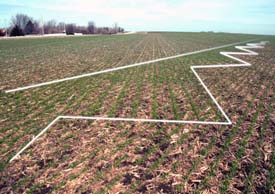 Seeded fields photo
Seeded fields photo
When commanded, electric over-hydraulic solenoids engage actuators to instantaneously close the gate for the needed section. The actuators are powered via hydraulics from the same circuit as the hydraulic drive motors. When power is cut, oil is diverted to retract the actuators and open the gates. The retraction is both powered and spring assisted, so it will always default to the seeding position. The oil from SectionCommand drains back through the fan motor case drain line and is coupled with an accumulator on the valve block to provide extra drainage capacity.
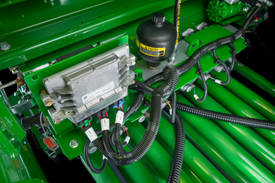 SectionCommand components as seen on back side of meter
SectionCommand components as seen on back side of meter
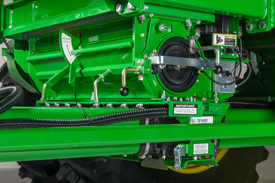 SectionCommand components as seen on front side of meter
SectionCommand components as seen on front side of meter
SectionCommand incorporates gate detection, which gives producers the satisfaction of knowing the gates are in position as commanded. Magnets on the back side of the gates are used in close proximity to the gate detection sensors to determine if the gates are open or closed. Should a gate not be in the commanded position, an alarm will alert the operator of the gate(s) in question. The blockage warning system works in conjunction with SectionCommand to give further confidence whether a given section is seeding or not when commanded.
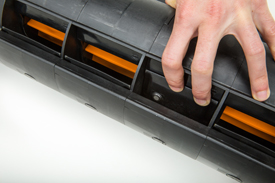 SectionCommand meter cartridge showing one gate closed and magnet on backside of gate
SectionCommand meter cartridge showing one gate closed and magnet on backside of gate
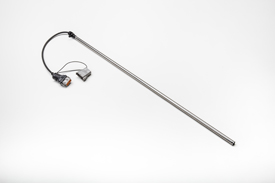 Gate detection sensor
Gate detection sensor
For maximum performance, SectionCommand should be controlled through John Deere Section Control. Coupling SectionCommand with John Deere Section Control provides the ultimate in precision seeding and productivity. If a Section Control activation is held by the producer, that same activation can be utilized for SectionCommand.
SectionCommand introduces the orange roller, which has the same number of flutes and spacing as the blue roller, but shorter flutes. It is for use only with SectionCommand when seeding seeds larger than 6 mm (0.25 in.) in diameter (soybeans, chick peas, etc.). The orange roller is not for use with cereal grains or fertilizer.
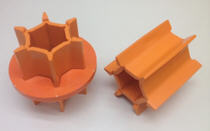 Orange roller for use only with large seeds and SectionCommand
Orange roller for use only with large seeds and SectionCommand
SectionCommand equalizer
Due to the varying lengths of product delivery hose used across the drill, SectionCommand has a built-in equalizer feature to ensure consistent product delivery across the width of the drill when entering and exiting headlands. The software allows the producer to set the on/off product delivery times separately for the outermost opener and the innermost opener on the drill. Product delivery times are inputted for each tank on the cart, and the software creates a time delay for actuation of the gates.
Please see the Using SectionCommand video for more information.
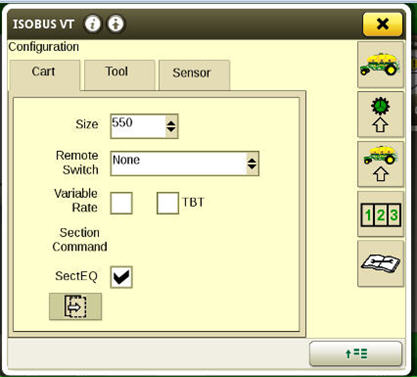 Enabling SectionCommand equalizer
Enabling SectionCommand equalizer
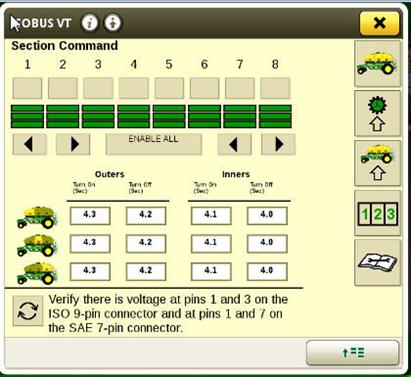 Input on/off times for outer opener versus inner opener on each tank
Input on/off times for outer opener versus inner opener on each tank